mileage HONDA PASSPORT 2000 2.G Owners Manual
[x] Cancel search | Manufacturer: HONDA, Model Year: 2000, Model line: PASSPORT, Model: HONDA PASSPORT 2000 2.GPages: 267, PDF Size: 3.03 MB
Page 161 of 267
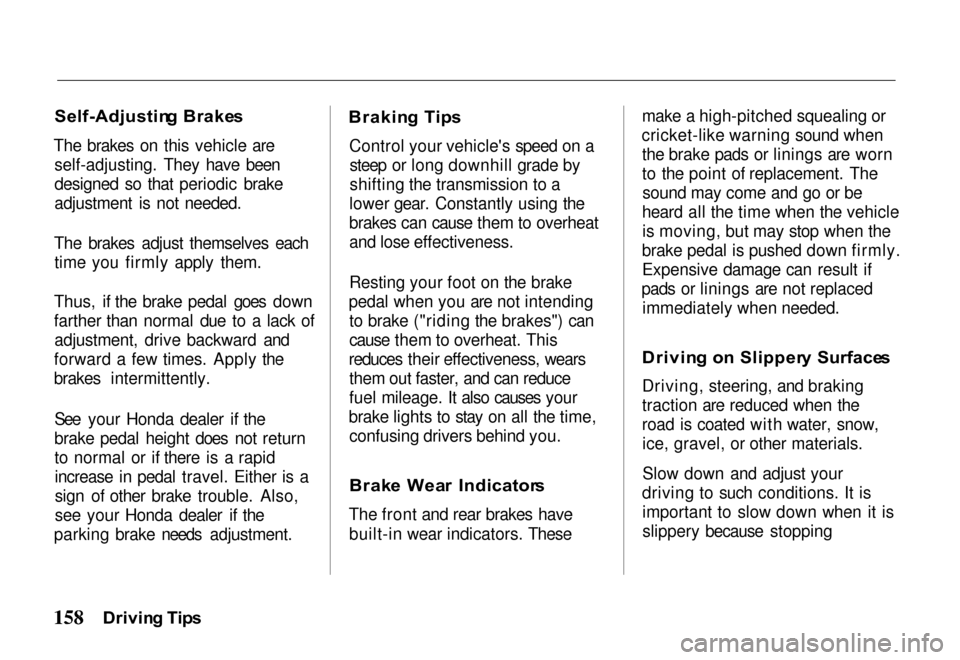
Self-Adjustin
g Brake s
The brakes on this vehicle are self-adjusting. They have been
designed so that periodic brake
adjustment is not needed.
The brakes adjust themselves each time you firmly apply them.
Thus, if the brake pedal goes down
farther than normal due to a lack of adjustment, drive backward and
forward a few times. Apply the
brakes intermittently.
See your Honda dealer if the
brake pedal height does not return
to normal or if there is a rapidincrease in pedal travel. Either is a
sign of other brake trouble. Also,
see your Honda dealer if the
parking brake needs adjustment.
Brakin
g Tip s
Control your vehicle's speed on a steep or long downhill grade by
shifting the transmission to a
lower gear. Constantly using the
brakes can cause them to overheat
and lose effectiveness.
Resting your foot on the brake
pedal when you are not intending to brake ("riding the brakes") can
cause them to overheat. This
reduces their effectiveness, wears them out faster, and can reduce
fuel mileage. It also causes your
brake lights to stay on all the time, confusing drivers behind you.
Brak e Wea r Indicator s
The front and rear brakes have built-in wear indicators. These make a high-pitched squealing or
cricket-like warning sound when the brake pads or linings are worn
to the point of replacement. Thesound may come and go or be
heard all the time when the vehicle is moving, but may stop when the
brake pedal is pushed down firmly.
Expensive damage can result if
pads or linings are not replaced immediately when needed.
Drivin g o n Slipper y Surface s
Driving, steering, and braking
traction are reduced when the
road is coated with water, snow, ice, gravel, or other materials.
Slow down and adjust your
driving to such conditions. It is important to slow down when it is
slippery because stopping
Drivin g Tip s
Page 168 of 267
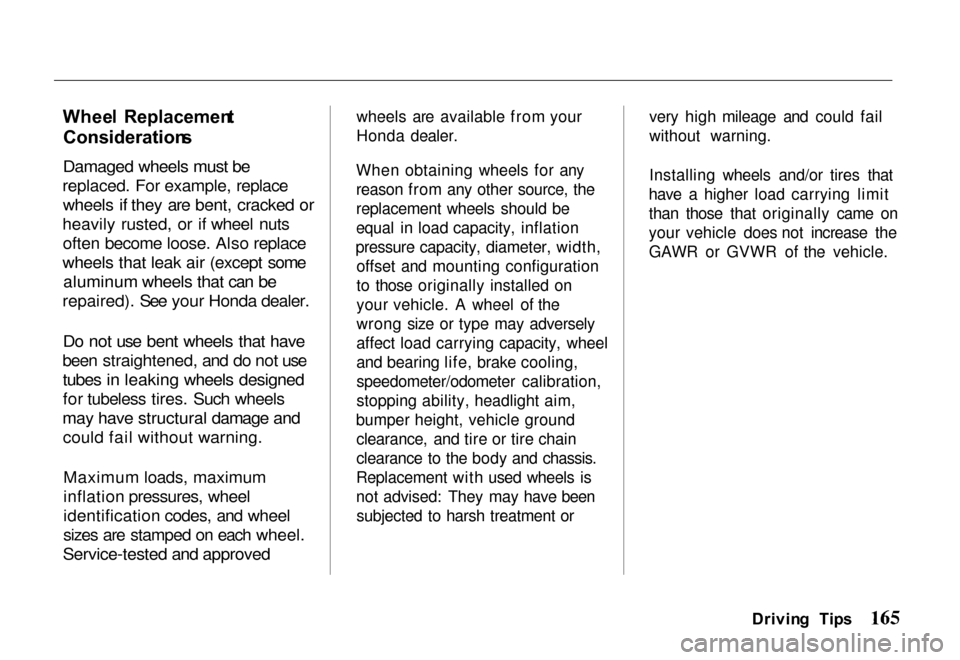
Whee
l Replacemen t
Consideration s
Damaged wheels must be
replaced. For example, replace
wheels if they are bent, cracked or
heavily rusted, or if wheel nuts
often become loose. Also replace
wheels that leak air (except some
aluminum wheels that can be
repaired). See your Honda dealer.
Do not use bent wheels that have
been straightened, and do not use
tubes in leaking wheels designed
for tubeless tires. Such wheels
may have structural damage and
could fail without warning.
Maximum loads, maximum
inflation pressures, wheel
identification codes, and wheel
sizes are stamped on each wheel.
Service-tested and approved
wheels are available from your
Honda dealer.
When obtaining wheels for any
reason from any other source, the
replacement wheels should be
equal in load capacity, inflation
pressure capacity, diameter, width, offset and mounting configuration
to those originally installed on
your vehicle. A wheel of the
wrong size or type may adversely
affect load carrying capacity, wheel
and bearing life, brake cooling,
speedometer/odometer calibration,
stopping ability, headlight aim,
bumper height, vehicle ground clearance, and tire or tire chain
clearance to the body and chassis.
Replacement with used wheels is
not advised: They may have been subjected to harsh treatment or very high mileage and could fail
without warning.
Installing wheels and/or tires that
have a higher load carrying limit
than those that originally came on
your vehicle does not increase the
GAWR or GVWR of the vehicle.
Driving Tip s
Page 172 of 267
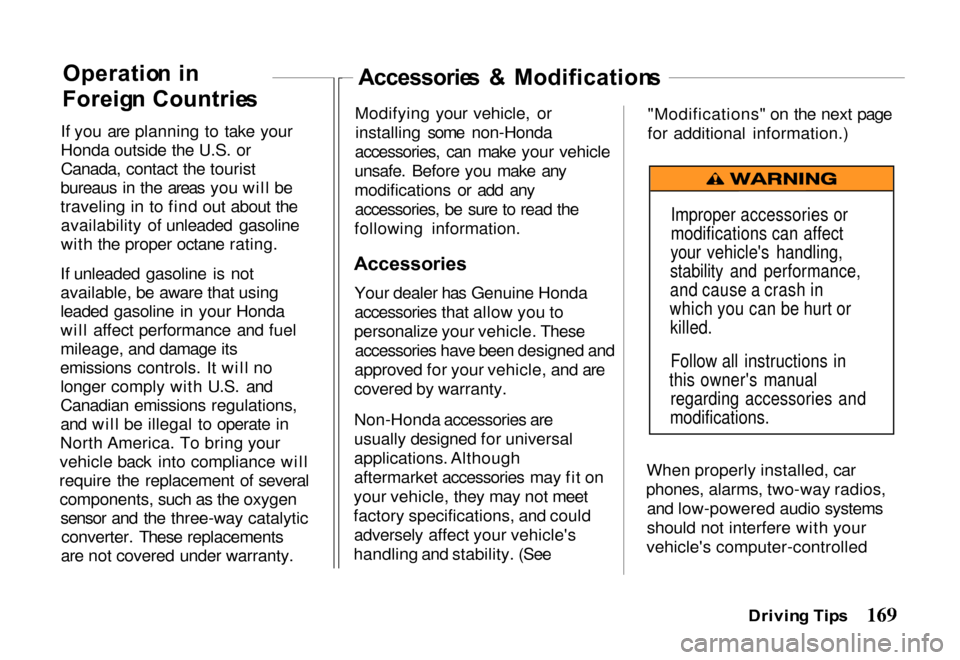
If you are planning to take your
Honda outside the U.S. or
Canada, contact the tourist
bureaus in the areas you will be
traveling in to find out about the availability of unleaded gasoline
with the proper octane rating.
If unleaded gasoline is not
available, be aware that using
leaded gasoline in your Honda
will affect performance and fuel
mileage, and damage its
emissions controls. It will no longer comply with U.S. and
Canadian emissions regulations,
and will be illegal to operate in
North America. To bring your
vehicle back into compliance will
require the replacement of several components, such as the oxygen sensor and the three-way catalyticconverter. These replacements
are not covered under warranty.
Accessorie
s & Modification s
Modifying your vehicle, or installing some non-Honda
accessories, can make your vehicle
unsafe. Before you make any
modifications or add any accessories, be sure to read the
following information.
Accessories
Your dealer has Genuine Honda
accessories that allow you to
personalize your vehicle. These accessories have been designed and
approved for your vehicle, and are
covered by warranty.
Non-Honda accessories are
usually designed for universal
applications. Although
aftermarket accessories may fit on
your vehicle, they may not meet
factory specifications, and could adversely affect your vehicle's
handling and stability. (See "Modifications" on the next page
for additional information.)
When properly installed, car
phones, alarms, two-way radios, and low-powered audio systems
should not interfere with your
vehicle's computer-controlled
Driving Tip s
Operatio
n i n
Foreig n Countrie s
Improper accessories or
modifications can affect
your vehicle's handling,
stability and performance,
and cause a crash in
which you can be hurt or killed.
Follow all instructions in
this owner's manual regarding accessories and
modifications.
Page 212 of 267
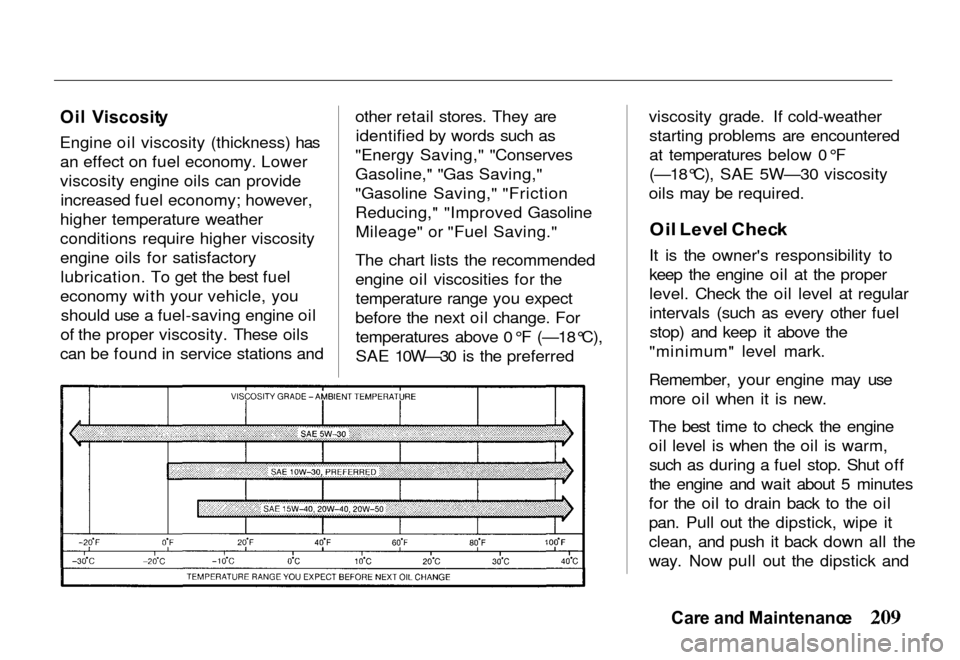
Oi
l Viscosit y
Engine oil viscosity (thickness) has an effect on fuel economy. Lower
viscosity engine oils can provideincreased fuel economy; however,
higher temperature weather
conditions require higher viscosity
engine oils for satisfactory lubrication. To get the best fuel
economy with your vehicle, you should use a fuel-saving engine oil
of the proper viscosity. These oils
can be found in service stations and other retail stores. They are
identified by words such as
"Energy Saving," "Conserves
Gasoline," "Gas Saving,"
"Gasoline Saving," "Friction
Reducing," "Improved Gasoline Mileage" or "Fuel Saving."
The chart lists the recommended
engine oil viscosities for the temperature range you expect
before the next oil change. For temperatures above 0°F (—18°C),
SAE 10W—30 is the preferred viscosity grade. If cold-weather
starting problems are encountered
at temperatures below 0°F
(—18°C), SAE 5W—30 viscosity
oils may be required.
Oi l Leve l Chec k
It is the owner's responsibility to
keep the engine oil at the proper
level. Check the oil level at regular
intervals (such as every other fuel stop) and keep it above the
"minimum" level mark.
Remember, your engine may use more oil when it is new.
The best time to check the engine
oil level is when the oil is warm, such as during a fuel stop. Shut off
the engine and wait about 5 minutes
for the oil to drain back to the oil
pan. Pull out the dipstick, wipe it
clean, and push it back down all the
way. Now pull out the dipstick and
Car e an d Maintenanc e
Page 215 of 267
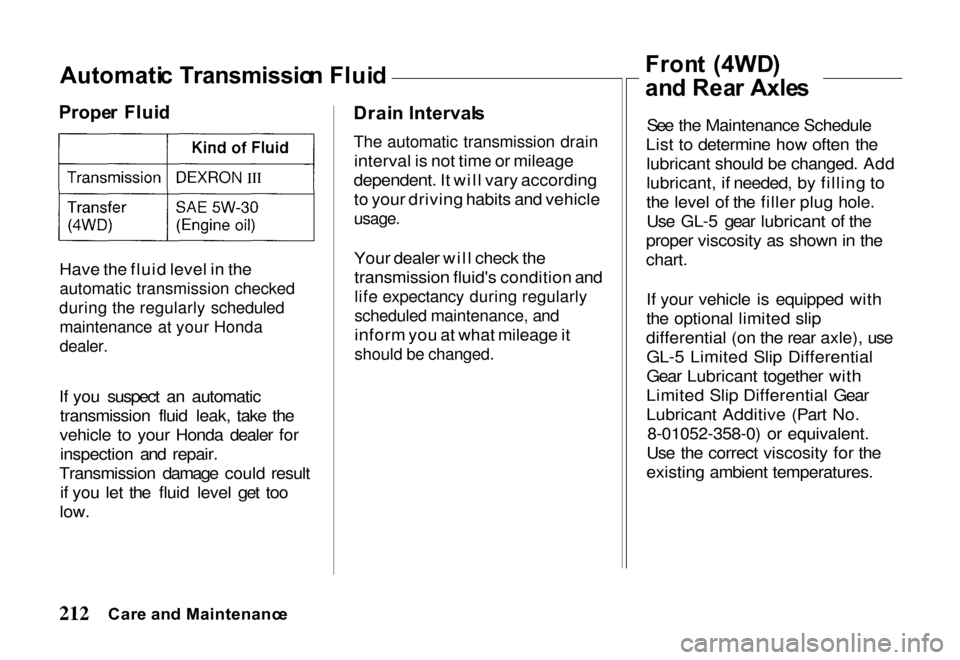
Automati
c Transmissio n Flui d
Prope r Flui d
Have the fluid level in the
automatic transmission checked
during the regularly scheduled maintenance at your Honda
dealer.
If you suspect an automatic transmission fluid leak, take the
vehicle to your Honda dealer for inspection and repair.
Transmission damage could result if you let the fluid level get too
low.
Drai
n Interval s
The automatic transmission drain
interval is not time or mileage
dependent. It will vary according to your driving habits and vehicle
usage.
Your dealer will check thetransmission fluid's condition and
life expectancy during regularly
scheduled maintenance, and
inform you at what mileage it
should be changed.
Fron
t (4WD )
an d Rea r Axle s
See the Maintenance Schedule
List to determine how often the lubricant should be changed. Add
lubricant, if needed, by filling to
the level of the filler plug hole.
Use GL-5 gear lubricant of the
proper viscosity as shown in the
chart.
If your vehicle is equipped with
the optional limited slip
differential (on the rear axle), use GL-5 Limited Slip Differential
Gear Lubricant together with
Limited Slip Differential Gear
Lubricant Additive (Part No. 8-01052-358-0) or equivalent.
Use the correct viscosity for the
existing ambient temperatures.
Car e an d Maintenanc e
Page 223 of 267
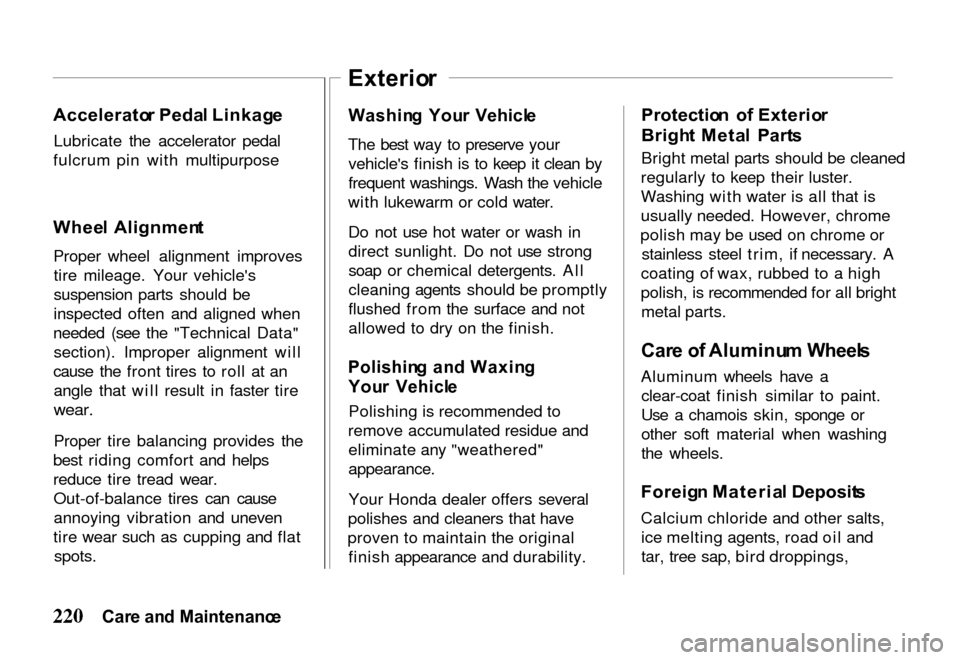
Accelerato
r Peda l Linkag e
Lubricate the accelerator pedal
fulcrum pin with multipurpose
Whee l Alignmen t
Proper wheel alignment improves tire mileage. Your vehicle's
suspension parts should be
inspected often and aligned when
needed (see the "Technical Data" section). Improper alignment will
cause the front tires to roll at an angle that will result in faster tire
wear.
Proper tire balancing provides the
best riding comfort and helps
reduce tire tread wear. Out-of-balance tires can cause
annoying vibration and uneven
tire wear such as cupping and flat
spots.
Exterio
r
Washin g You r Vehicl e
The best way to preserve your vehicle's finish is to keep it clean by
frequent washings. Wash the vehicle
with lukewarm or cold water.
Do not use hot water or wash in direct sunlight. Do not use strong
soap or chemical detergents. All
cleaning agents should be promptly
flushed from the surface and not
allowed to dry on the finish.
Polishin g an d Waxin g
You r Vehicl e
Polishing is recommended to
remove accumulated residue and eliminate any "weathered"
appearance.
Your Honda dealer offers several
polishes and cleaners that have
proven to maintain the original finish appearance and durability. Protectio
n o f Exterio r
Brigh t Meta l Part s
Bright metal parts should be cleaned
regularly to keep their luster.
Washing with water is all that is
usually needed. However, chrome
polish may be used on chrome or stainless steel trim, if necessary. A
coating of wax, rubbed to a high
polish, is recommended for all bright metal parts.
Car e o f Aluminu m Wheel s
Aluminum wheels have a clear-coat finish similar to paint.
Use a chamois skin, sponge or
other soft material when washing
the wheels.
Foreig n Materia l Deposit s
Calcium chloride and other salts, ice melting agents, road oil and
tar, tree sap, bird droppings,
Car e an d Maintenanc e
Page 245 of 267
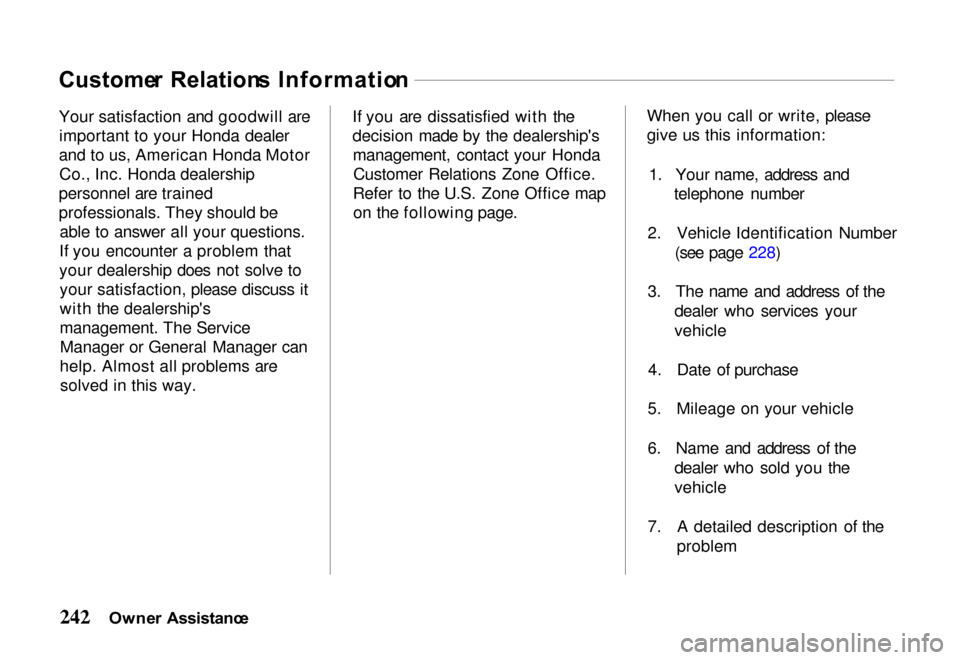
Custome
r Relation s Informatio n
Your satisfaction and goodwill are important to your Honda dealer
and to us, American Honda Motor Co., Inc. Honda dealership
personnel are trained
professionals. They should be able to answer all your questions.
If you encounter a problem that
your dealership does not solve to your satisfaction, please discuss it
with the dealership's
management. The ServiceManager or General Manager can
help. Almost all problems are solved in this way. If you are dissatisfied with the
decision made by the dealership's
management, contact your HondaCustomer Relations Zone Office.
Refer to the U.S. Zone Office map on the following page. When you call or write, please
give us this information:
1. Your name, address and telephone number
2. Vehicle Identification Number (see page 228)
3. The name and address of the dealer who services your
vehicle
4. Date of purchase
5. Mileage on your vehicle
6. Name and address of the dealer who sold you the
vehicle
7. A detailed description of the problem
Owne r Assistanc e
Page 247 of 267
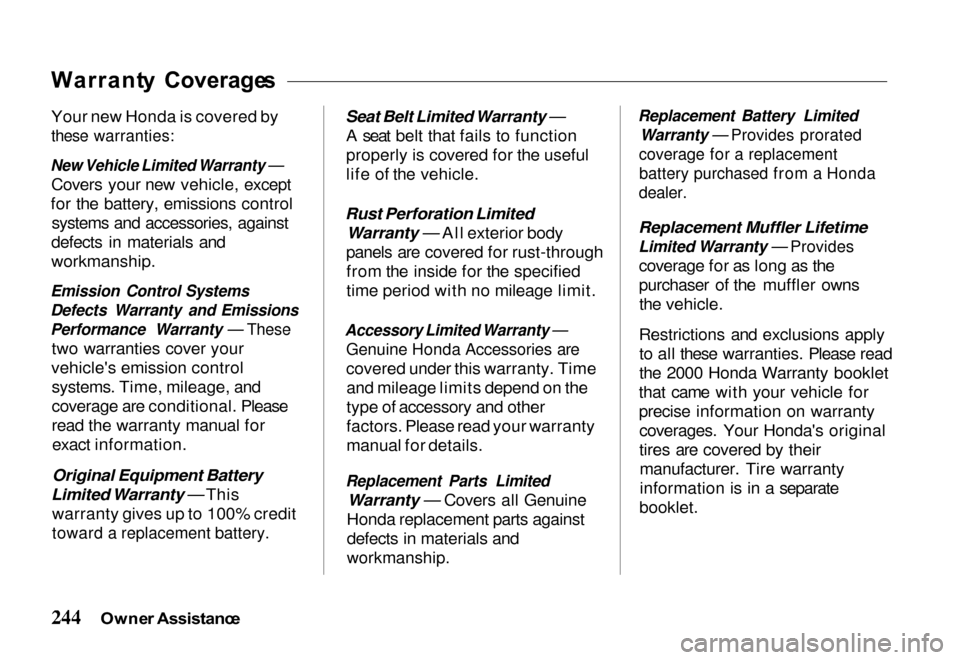
Warrant
y Coverage s
Your new Honda is covered by
these warranties:
New Vehicle Limited Warranty —
Covers your new vehicle, except
for the battery, emissions control systems and accessories, against
defects in materials and
workmanship.
Emission Control Systems
Defects Warranty and Emissions
Performance Warranty — These
two warranties cover your
vehicle's emission control systems. Time, mileage, and
coverage are conditional. Please
read the warranty manual forexact information.
Original Equipment Battery
Limited Warranty — This warranty gives up to 100% credit
toward a replacement battery.
Seat Belt Limited Warranty —
A seat belt that fails to function
properly is covered for the useful
life of the vehicle.
Rust Perforation Limited Warranty — All exterior body
panels are covered for rust-through from the inside for the specified
time period with no mileage limit.
Accessory Limited Warranty —
Genuine Honda Accessories are
covered under this warranty. Timeand mileage limits depend on the
type of accessory and other
factors. Please read your warranty
manual for details.
Replacement Parts Limited
Warranty — Covers all Genuine
Honda replacement parts against
defects in materials and
workmanship.
Replacement Battery Limited
Warranty — Provides prorated
coverage for a replacement
battery purchased from a Honda
dealer.
Replacement Muffler Lifetime
Limited Warranty — Provides
coverage for as long as the
purchaser of the muffler ownsthe vehicle.
Restrictions and exclusions apply to all these warranties. Please read
the 2000 Honda Warranty booklet
that came with your vehicle for
precise information on warranty coverages. Your Honda's original
tires are covered by theirmanufacturer. Tire warranty
information is in a separate
booklet.
Owne r Assistanc e
Page 259 of 267
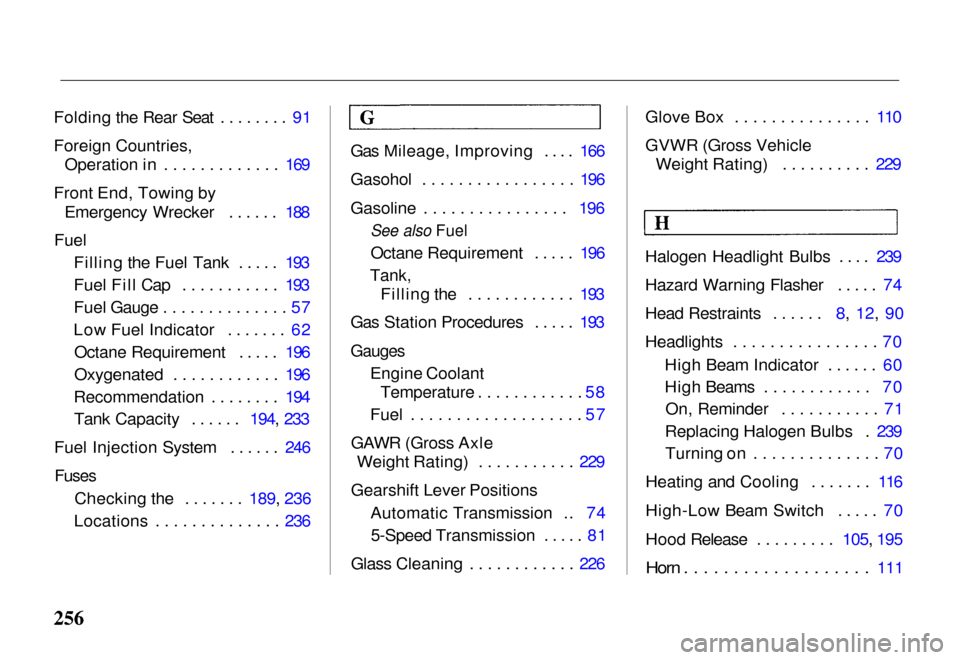
Folding the Rear Seat ........ 91
Foreign Countries,
Operation in ............. 169
Front End, Towing by Emergency Wrecker ...... 188
Fuel Filling the Fuel Tank ..... 193
Fuel Fill Cap ........... 193
Fuel Gauge .............. 57
Low Fuel Indicator ....... 62Octane Requirement ..... 196
Oxygenated ............ 196
Recommendation ........ 194 Tank Capacity ...... 194, 233
Fuel Injectio
n System ...... 246
Fuses
Checking the .......
189, 236
Locations .............
. 236Gas Mileage, Improving .... 166
Gasohol ................. 196
Gasoline ................ 196
See also Fuel
Octane Requirement ..... 196
Tank,
Filling the ............ 193
Gas Station Procedures ..... 193
Gauges
Engine CoolantTemperature ............ 58
Fuel ................... 57
GAWR (Gross Axle Weight Rating) ........... 229
Gearshift Lever Positions Automatic Transmission .. 745-Speed Transmission ..... 81
Glass Cleaning ............ 226 Glove Box ............... 110
GVWR (Gross Vehicle
Weight Rating) .......... 229
Halogen Headlight Bulbs .... 239
Hazard Warning Flasher ..... 74
Head Restraints ...... 8, 12, 90
Headlights ................ 70 High Beam Indicator ...... 60
High Beams ............ 70On, Reminder ........... 71
Replacing Halogen Bulbs . 239 Turning on .............. 70
Heating and Cooling ....... 116
High-Low Beam Switch ..... 70
Hood Release ......... 105, 195
Horn ...................
111